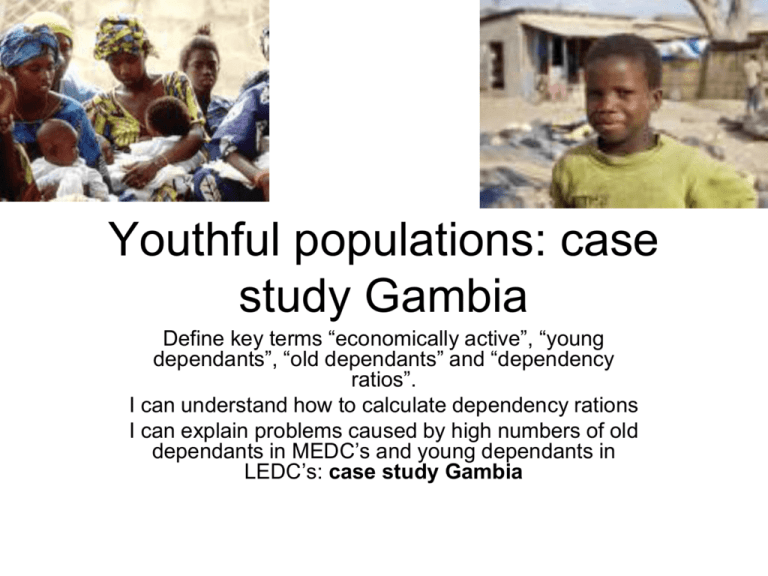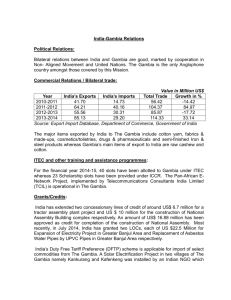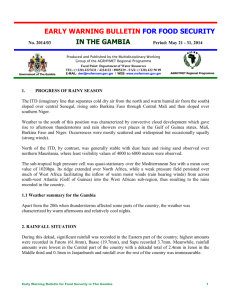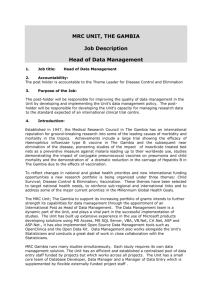Youthful populations
advertisement

Youthful populations: case study Gambia Define key terms “economically active”, “young dependants”, “old dependants” and “dependency ratios”. I can understand how to calculate dependency rations I can explain problems caused by high numbers of old dependants in MEDC’s and young dependants in LEDC’s: case study Gambia Key terms: Economically active: The total population between the ages of 15 and 65 in any country Youthful population: A population with a high proportion of young people usually under the age of 16 or 18 Old dependants: A population with a high proportion of old people usually over the age of 65 Dependency ratio: A measure showing the number of dependents (aged 0-14 and over the age of 65) to the total population (aged 15-64). Dependency ratio: • Calculated by: This indicator gives insight into the amount of people of non-working age compared to the number of those of working age. A high ratio means those of working age - and the overall economy - face a greater burden in supporting the aging population. The young dependency ratio includes only under 15s, and the elderly dependency ratio focuses on those over 64. For example, if in a population of 1,000 there are 250 people under the age of 15 and 500 people between the ages of 15-64. The youth dependency ratio would be 50% (250/500). UK Children – Triangular 30% Adults – 58% Elderly – Children 12% Elderly graphs This type of graph may also be included on paper1: Geographical skills Adults UK Japan Ghana Brazil World Childre n 30 22 65 38 45 Adults Elderly 58 56 33 54 48 12 22 2 8 7 Youthful Populations: Where/Why? • High proportion of young people due to high birth rates and a reduction in infant mortality. This is due to better nutrition, education and medical care. • This may create problems since the children need feeding, housing, education and eventually a job. • Medical care and education has to be paid for by taxing a proportionally small number of workers. Youthful Population Structure (Population Pyramids) Seen as a wide base on population pyramids that reflect high birth rates in LEDCs. Youthful Population Structure (DTM) • Stage 2: • This is where the birth rates are high but the death rates begin to fall. • This results in the population increasing. • Lots of countries in the developing world are at this stage, due to improved medical care, but poor education. The Gambia The Gambia is the smallest African country 95% of Gambia’s population are Muslim. There has been a taboo on contraceptives The birth rate is 40 per 1000 population A Typical Gambian Woman Fertility rate: Other Factors that may lead to a growing population in The Gambia The Desire for a large family remains strong. Larger families are seen as a sign of security. The Stigma and cost of contraceptionlinks to religious background. Case study notes from DVD: The Gambia • Youthful populations: Case study Gambia • Why do Gambian women have so many children? • What will be the impacts of a large population for Gambia in the future? • What has been done abut the youthful population? Large potential workforce Cost of schools and clinics Need to provide food, housing and water to growing population High rates of unemployment Attractive to new investors Source of innovation and ideas Large numbers living in slum housing High crime rates High rate of population growth Large market for potential goods Development of services such as schools Political instability due to unsatisfactory living standards Many countries lack economy to take advantage of extra workers Example of innovations from a youthful population https://www.youtube.com/watch?t=110&v=J ci-_Vu5UYY Why and how have young Africans developed mobile phone technology? 6 mark case study question from May 2015 This means Both positive that SPAG will be considered You need to say why it is a positive or negative and negative needed (not necessarily equally) Always use case study detail in a 6 mark question (even if it is not asked for) Mark scheme






